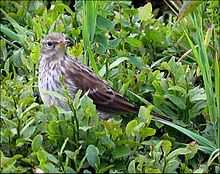Water Pipit
| Water Pipit | |
|---|---|
 | |
| Conservation status | |
| Scientific classification | |
| Kingdom: | Animalia |
| Phylum: | Chordata |
| Class: | Aves |
| Order: | Passeriformes |
| Family: | Motacillidae |
| Genus: | Anthus |
| Species: | A. spinoletta |
| Binomial name | |
| Anthus spinoletta (Linnaeus, 1758) | |
The Water Pipit (Anthus spinoletta) is a small passerine bird which breeds in the mountains of southern Europe and southern temperate Asia across to China. It is a short-distance migrant moving to wet open lowlands such as marshes and flooded fields in winter. Some birds migrate north to Britain for winter, taking advantage of the warm oceanic climate[citation needed].
Like most other pipits, this is an undistinguished looking species on the ground, mainly brown above and dark streaked buff below. It has dark legs, white outer tail feathers and a longish dark bill. In summer it has a distinctive breeding plumage, with a pinkish breast, grey head and pale supercilium.[2][3]
The Eurasian Rock Pipit's subspecies littoralis in summer plumage is very close in outward appearance to the Water Pipit however. They can be told apart by their song,[4] and occupy different habitat types even when they occur in the same general area.[5] The Water Pipit is also much less approachable than the Eurasian Rock Pipit, rising high and quickly leaving the vicinity when approached. Water and Buff-bellied Pipit do not co-occur except in a small area in Central Asia.[6]
This species is insectivorous. Its call is an explosive "fit", like Eurasian Rock Pipit. Its song is similar, but it consisting of maybe 5 "blocks" of just about half a dozen notes each (the Eurasian Rock Pipit has fewer, but longer blocks); it ends either with no or with repeated trills.[5]
Formerly included in the Water Pipit were the subspecies now separated as Rock Pipit and Buff-bellied Pipit.[7] The former is more closely related to the Water Pipit than the latter, as indicated by external[2] and molecular characteristics.[8]
References
- ↑ BirdLife International (2012). "Anthus spinoletta". IUCN Red List of Threatened Species. Version 2013.2. International Union for Conservation of Nature. Retrieved 26 November 2013.
- ↑ 2.0 2.1 Per Alström & Krister Mild (1996). "The identification of Rock, Water and Buff-bellied Pipits". Alula 2 (4): 161–175.
- ↑ Per Alström & Krister Mild (1987). "Some notes on the taxonomy of the Water Pipit complex". Proceedings of the 4th International Identification Meeting. Eilat: International Birdwatching Center. pp. 47–48.
- ↑ V. V. Leonovich, G. V. Deminia & O. D. Veprintseva (1997). "On the taxonomy and phylogeny of pipits (Genus Anthus, Motacillidae, Aves) in Eurasia". Biulleten Moskovskogo obshchestva ispytatelei prirody. Otdel biologicheskii (in Russian) 102 (2): 14–22.
- ↑ 5.0 5.1 R. Bijlsma (1977). "Voorkomen en oecologie van Anthus spinoletta en A. s. littoralis in de uiterwaarden van de Rijn bij Wageningen". Limosa (in Dutch) 50: 127–136.
- ↑ A. A. Nazarenko (1978). "On species validity of Anthus rubescens Tunstall (Aves: Motacillidae)". Zoologicheskiy Zhurnal (in Russian) 57: 1743–1744.
- ↑ George Sangster, Alan G. Knox, Andreas J. Helbig & David T. Parkin (2002). "Taxonomic recommendations for European Birds". Ibis 144 (1): 153–159. doi:10.1046/j.0019-1019.2001.00026.x.
- ↑ G. Voelker (1999). "Molecular evolutionary relationships in the avian genus Anthus (Pipits: Motacillidae)". Molecular Phylogenetics and Evolution 11 (1): 84–94. doi:10.1006/mpev.1998.0555. PMID 10082613.
External links
| Wikimedia Commons has media related to Anthus spinoletta. |
| Wikispecies has information related to: Anthus spinoletta |
- Ageing and sexing (PDF; 3.3 MB) by Javier Blasco-Zumeta & Gerd-Michael Heinze
- Avibase Links in turn to Flckr Handguide
